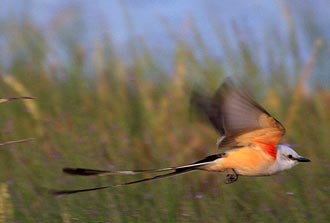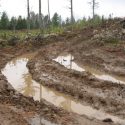Migratory birds bear brunt of climate-charged weather
As global climate change fuels more frequent and intense hurricanes and droughts, migratory birds, especially those whose populations are already in decline, will bear the brunt of such climate-fueled weather, suggest a pair of new studies.

A scissor-tailed flycatcher flits through Texas’ Cross Timbers region May 11, 2007. A pair of research studies from the UW–Madison labs of Anna Pidgeon and Volker Radeloff suggest that North America’s breeding birds, especially those that migrate to Central and South America, are at risk from the increasing incidence of climate change-fueled severe weather, hurricanes and drought in particular.
Photo: courtesy Bruce Rosenstiel
Writing in the December online issue of the journal Global Change Biology, researchers from the University of Wisconsin–Madison describe the effects of intense, climate-charged weather on North America’s birds.
The studies, which focused on the influence of drought and forest-leveling hurricanes, show that neotropical migrants — birds that spend the winter in tropical or subtropical regions of North, Central and South America and breed in temperate North America — are most vulnerable to the growing risk of severe weather.
“Extreme climate events are increasing in frequency and intensity,” explains Anna Pidgeon, a UW–Madison professor of forest and wildlife ecology and a senior author of both of the new studies. “We’re seeing a decrease in abundance in response to drought and hurricanes, especially with species that have small populations.”
The study of the influence of drought on birds looked at the effects of prolonged dry spells on birds in a 15-state region centered on the U.S Great Plains. In that study, the Wisconsin researchers coupled data from the North American Breeding Bird Survey with precipitation measurements gleaned from more than 1,600 weather stations during a period of about 15 years beginning in 1989. In addition, the study utilized seasonal greenness measurements as recorded by satellite.
“The effects of drought get stronger as you look at uncommon birds,” explains Thomas Albright, the lead author of the drought study and postdoctoral fellow at UW–Madison. In particular, drought seems to weigh most heavily on neotropical migrants. “We found those decreasing in quantity compared to average birdlife overall.”
More common birds, especially those that make their homes in North American year-round and that are familiar denizens of the backyard bird feeder, tended to be less influenced by drought conditions, according to Albright. Also, the effects of drought on all birds in mountainous regions are fewer.
Hurricanes batter birds for the most part by destroying forest habitat, says Chadwick Rittenhouse, a UW–Madison postdoctoral fellow and the lead author of the study on the effects of the giant storms on birds. The study linked hurricane track data in the Eastern and Southeastern U.S, with North American Breeding Bird Survey data and Landsat images to assess the impact of the big storms on avian diversity.
“The idea is to see where hurricane damage is occurring, look at the effects on bird populations in those areas and compare that with data from areas not damaged by hurricanes,” notes Rittenhouse.
The big surprise of the hurricane study, says Rittenhouse, was not the types of birds affected, but the fact that a hurricane’s influence on birds extends much beyond the destructive path of the storm.
“The effect (on birds) extends far beyond the affected area. We see changes in bird communities 100 kilometers on either side of the storm track,” Rittenhouse says.
During the past 20 years, hurricanes have increased in both frequency and intensity as global climate change has warmed the world’s oceans, increasing the energy available for the monster storms.
Rittenhouse explains that coastal forests are critical habitat for many different kinds of birds, and some birds, especially those with small populations or specialized habitat needs, can be vulnerable to forest-churning storms. Hurricane Hugo, a Category 5 hurricane that struck the Carolinas in 1989, for example, had a disastrous impact on the red-cockaded woodpecker, a bird whose population has shrunk to only about 13,000 and which depends on mature pine forests for breeding habitat.
The new study, argues Rittenhouse, demonstrates the need to ensure enough forest habitat to buffer the effects of big storms on birds.
Both studies were supported by grants from NASA’s Biodiversity Program and NASA’s Interdisciplinary Sciences Program.



